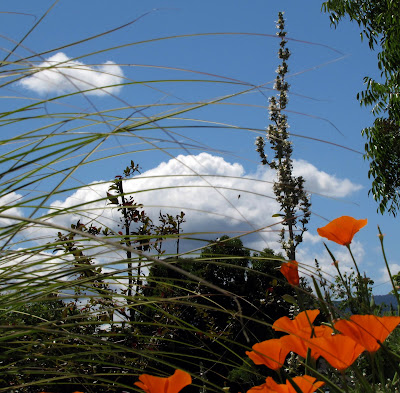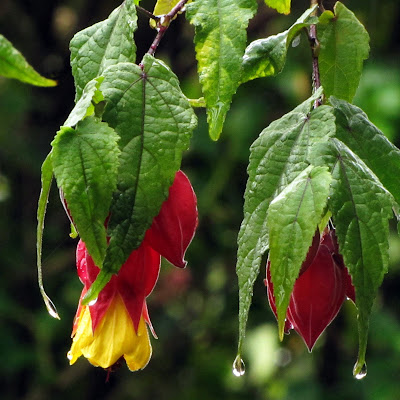 It may surprise you to learn what a 'fair weather' gardener I am. The only time of year I really get my hands in the dirt is a narrow window in the spring, usually April-May. That's when new plants are introduced, old ones removed or relocated, and any major projects done. Whatever hasn't been checked off my list by June simply has to wait; my creative energy must shift firmly and fully to my clients, and apart from a flurry of fall cleanup, won't be back again that season.
It may surprise you to learn what a 'fair weather' gardener I am. The only time of year I really get my hands in the dirt is a narrow window in the spring, usually April-May. That's when new plants are introduced, old ones removed or relocated, and any major projects done. Whatever hasn't been checked off my list by June simply has to wait; my creative energy must shift firmly and fully to my clients, and apart from a flurry of fall cleanup, won't be back again that season.I have learned to accept this about myself, but it is kind of a frustrating phenomenon. I mean, when you're a gardener you're a gardener all the way, from your first window box 'till your last dying day, right? Nope. I'll tidy, weed, harvest and prune a bit year-round, but everything you see in my garden that is creative or designer-ly was done in the Spring.
As I've said before, I want to LIVE in a garden, photograph it, write about it, but not work in it! I'm grateful that I don't have a lawn that needs weekly mowing, and that most of my regular gardening chores can be done in my typical drive-by fashion. I simply don't have the energy for anything more, although I am continually making mental wish-lists of changes I'd make (don't YOU wish you could move plants with your mind? There must be an app for that, right?)
 So I really appreciate garden-centric 'happenings' that encourage me to get out of my head, into the dirt, and cross a few more things off that wish-list. This past weekend was one such event, the visit of my friend Michelle Gervais, who is an editor at Fine Gardening Magazine.
So I really appreciate garden-centric 'happenings' that encourage me to get out of my head, into the dirt, and cross a few more things off that wish-list. This past weekend was one such event, the visit of my friend Michelle Gervais, who is an editor at Fine Gardening Magazine.Preparing my home and garden for Michelle's visit (and the small gathering of local garden writers and designers that I hosted for her) was exactly the impetus I needed to prepare my creation for its closeup. But with a busy work schedule and limited resources, how much could be done? Well, thanks to my terrific parents who love helping their kids with projects, quite a lot!
 It started with a new side gate. My old one had disintegrated over the winter, and was a sorry, sorry sight. Dad and I designed a new one, and he built it with his usual attention to detail. Dad does structure, Mom does color; she helped pick the stain, and then stained it herself. (BTW that's Behr semi-transparent wood stain in 'Chestnut' and it's perfect!)
It started with a new side gate. My old one had disintegrated over the winter, and was a sorry, sorry sight. Dad and I designed a new one, and he built it with his usual attention to detail. Dad does structure, Mom does color; she helped pick the stain, and then stained it herself. (BTW that's Behr semi-transparent wood stain in 'Chestnut' and it's perfect!) Actually, it started with this gate. Finished a year ago, and waiting all this time for a decision on stain color; a perfect example of my "if not done by June" thing. Same with the three porch posts; primed, but not painted. Thank goodness the blue fence made it under the wire last year! The three of us took care of these tasks in an afternoon.
Actually, it started with this gate. Finished a year ago, and waiting all this time for a decision on stain color; a perfect example of my "if not done by June" thing. Same with the three porch posts; primed, but not painted. Thank goodness the blue fence made it under the wire last year! The three of us took care of these tasks in an afternoon. Then Dad got a truckload of my favorite gravel to topdress the paths. I had been experimenting with loose gravel vs. gold fines in different areas, and decided after a year that I prefer the look of the gravel (even though it's fussier) and it felt wonderful to have all the paths brought up to the proper level. My vintage colored step stone 'hopscotch' path looks especially nice.
Then Dad got a truckload of my favorite gravel to topdress the paths. I had been experimenting with loose gravel vs. gold fines in different areas, and decided after a year that I prefer the look of the gravel (even though it's fussier) and it felt wonderful to have all the paths brought up to the proper level. My vintage colored step stone 'hopscotch' path looks especially nice. My main focus was the garden itself. I removed armloads of California Poppy plants which had started to straggle and overwhelm their neighbors. Their progeny will return with the fall rains, but for now I finally had room to plant some of the patient inhabitants of my nursery; another relief.
My main focus was the garden itself. I removed armloads of California Poppy plants which had started to straggle and overwhelm their neighbors. Their progeny will return with the fall rains, but for now I finally had room to plant some of the patient inhabitants of my nursery; another relief. Two last touches (completed yesterday) were particularly satisfying. The first was this small succulent bed in the sunny spot in front of the porch; another couple dozen nursery dwellers finally have homes! This has been my catch-all spot since the garden was built, nice to finally finish it off with some style.
Two last touches (completed yesterday) were particularly satisfying. The first was this small succulent bed in the sunny spot in front of the porch; another couple dozen nursery dwellers finally have homes! This has been my catch-all spot since the garden was built, nice to finally finish it off with some style. My last task for the season (seriously, this is probably it!) was to rebuild the catch-basin for my rain chain. I had used an upside-down plastic pot with a slit cut in the bottom to firmly anchor the chain and fill up the volume of the pot while keeping the drainage hole clear (there is a drain directly underneath the pot itself.) That pot collapsed on itself last fall, so I made it stronger by using pavers and drain rock for the main filler.
My last task for the season (seriously, this is probably it!) was to rebuild the catch-basin for my rain chain. I had used an upside-down plastic pot with a slit cut in the bottom to firmly anchor the chain and fill up the volume of the pot while keeping the drainage hole clear (there is a drain directly underneath the pot itself.) That pot collapsed on itself last fall, so I made it stronger by using pavers and drain rock for the main filler. On top goes a circular screen (this is actually a spatter screen meant to be used with a frying pan; I removed the center handle to make a hole for the chain.) This will keep fine debris from the roof out of the drain. It's then covered with half an inch or so of decorative pebbles.
On top goes a circular screen (this is actually a spatter screen meant to be used with a frying pan; I removed the center handle to make a hole for the chain.) This will keep fine debris from the roof out of the drain. It's then covered with half an inch or so of decorative pebbles. All finished and ready for the next rainy season! None of these tasks took more than a few hours, but together they added so much. And I realize with some bemusement that I probably THOUGHT about each of these projects longer than it took to actually do them. Oh well. Creativity takes what it takes; and sometimes its not the doing but the deciding how and what to do that simply takes time.
All finished and ready for the next rainy season! None of these tasks took more than a few hours, but together they added so much. And I realize with some bemusement that I probably THOUGHT about each of these projects longer than it took to actually do them. Oh well. Creativity takes what it takes; and sometimes its not the doing but the deciding how and what to do that simply takes time.So, I really WOULD like to get those parkway beds done, and the corps yard cleaned up, add proper irrigation to the nursery and clean out the shed. Perhaps my upcoming Summer Solstice Garden Party will inspire the completion of those tasks, but until then, there's always next year!
Thanks again to my folks Phil and Judy for coming to my aid. Once again their skills and energy helped me accomplish more than I ever could alone. I am, as always, so grateful.














































